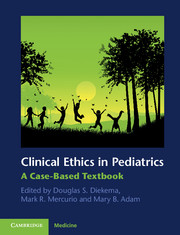Book contents
- Frontmatter
- Contents
- Contributors
- Preface
- Section 1 Core issues in clinical pediatric ethics
- Section 2 Ethical issues at the beginning of life: perinatology and neonatology
- Section 3 When a child dies: ethical issues at the end of life
- 18 End-of-life care: resolving disputes over life-sustaining interventions
- 19 Futility
- 20 Advance directives and DNR orders
- 21 The determination of death
- 22 Physician-assisted dying in children
- 23 The Groningen Protocol
- 24 Defining beneficence in the face of death: symptom management in dying children
- Section 4 Ethical issues posed by advances in medical technology and science
- Section 5 Children, public health, and justice
- Section 6 Special topics in pediatric ethics
- Index
- References
24 - Defining beneficence in the face of death: symptom management in dying children
from Section 3 - When a child dies: ethical issues at the end of life
Published online by Cambridge University Press: 07 October 2011
- Frontmatter
- Contents
- Contributors
- Preface
- Section 1 Core issues in clinical pediatric ethics
- Section 2 Ethical issues at the beginning of life: perinatology and neonatology
- Section 3 When a child dies: ethical issues at the end of life
- 18 End-of-life care: resolving disputes over life-sustaining interventions
- 19 Futility
- 20 Advance directives and DNR orders
- 21 The determination of death
- 22 Physician-assisted dying in children
- 23 The Groningen Protocol
- 24 Defining beneficence in the face of death: symptom management in dying children
- Section 4 Ethical issues posed by advances in medical technology and science
- Section 5 Children, public health, and justice
- Section 6 Special topics in pediatric ethics
- Index
- References
Summary
Case narrative
Cole is an 8-month-old first-born child, diagnosed at 4 months of age with Werdnig–Hoffmann disease (spinal muscular atrophy, SMA 1), a severe form of autosomal recessive muscular dystrophy. SMA 1 has historically led to death from respiratory insufficiency before age 2 and is incurable. Cole’s parents are aware of the nature and prognosis of his condition and have been apprised of all potential measures to prolong Cole’s life and enhance his comfort.
Cole presents to the palliative care team with a 2-week history of irritability, frequent night-time awakenings, and increasingly frequent and brief daytime naps. He is afebrile and has no new symptoms. His respiratory rate is 60 per minute and shallow; a full physical examination is otherwise unremarkable. Cole’s parents report that shortly after commencing sleep, his breathing becomes shallower and then he awakens, never getting adequate rest. Though not in severe distress, it is very likely that the etiology of his irritability is borderline respiratory insufficiency when awake, resulting in sleep disruption and deprivation, which is further exacerbated by the decreased conscious control of breathing when asleep. No soporifics are approved for this age group. Further, any lessening of his consciousness risks respiratory failure and even respiratory arrest. Cole’s parents remain adamant that they wish no form of mechanical respiratory support.
- Type
- Chapter
- Information
- Clinical Ethics in PediatricsA Case-Based Textbook, pp. 137 - 142Publisher: Cambridge University PressPrint publication year: 2011



